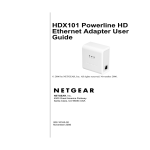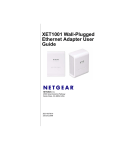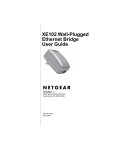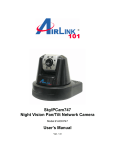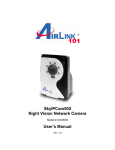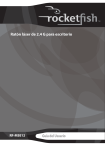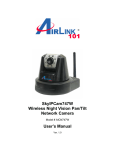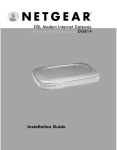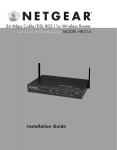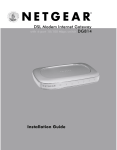Download Netgear XE104 User's Manual
Transcript
XE104 User Guide © 2005 by NETGEAR, Inc. All rights reserved. September 2005. NETGEAR, Inc. 4500 Great America Parkway Santa Clara, CA 95054 USA 202-10131-01 September 2005 Trademarks NETGEAR is a trademark of Netgear, Inc. Microsoft, Windows, and Windows NT are registered trademarks of Microsoft Corporation. Other brand and product names are registered trademarks or trademarks of their respective holders. Statement of Conditions In the interest of improving internal design, operational function, and/or reliability, NETGEAR reserves the right to make changes to the products described in this document without notice. NETGEAR does not assume any liability that may occur due to the use or application of the product(s) or circuit layout(s) described herein. Federal Communications Commission (FCC) Compliance Notice: Radio Frequency Notice This equipment has been tested and found to comply with the limits for a Class B digital device, pursuant to part 15 of the FCC Rules. These limits are designed to provide reasonable protection against harmful interference in a residential installation. This equipment generates, uses, and can radiate radio frequency energy and, if not installed and used in accordance with the instructions, may cause harmful interference to radio communications. However, there is no guarantee that interference will not occur in a particular installation. If this equipment does cause harmful interference to radio or television reception, which can be determined by turning the equipment off and on, the user is encouraged to try to correct the interference by one or more of the following measures: • Reorient or relocate the receiving antenna. • Increase the separation between the equipment and receiver. • Connect the equipment into an outlet on a circuit different from that to which the receiver is connected. • Consult the dealer or an experienced radio/TV technician for help. Bestätigung des Herstellers/Importeurs Es wird hiermit bestätigt, daß das XE104 85 Mbps Wall-Plugged Ethernet Switch gemäß der im BMPT-AmtsblVfg 243/ 1991 und Vfg 46/1992 aufgeführten Bestimmungen entstört ist. Das vorschriftsmäßige Betreiben einiger Geräte (z.B. Testsender) kann jedoch gewissen Beschränkungen unterliegen. Lesen Sie dazu bitte die Anmerkungen in der Betriebsanleitung. Das Bundesamt für Zulassungen in der Telekommunikation wurde davon unterrichtet, daß dieses Gerät auf den Markt gebracht wurde und es ist berechtigt, die Serie auf die Erfüllung der Vorschriften hin zu überprüfen. Certificate of the Manufacturer/Importer It is hereby certified that the XE104 85 Mbps Wall-Plugged Ethernet Switch has been suppressed in accordance with the conditions set out in the BMPT-AmtsblVfg 243/1991 and Vfg 46/1992. The operation of some equipment (for example, test transmitters) in accordance with the regulations may, however, be subject to certain restrictions. Please refer to the notes in the operating instructions. Federal Office for Telecommunications Approvals has been notified of the placing of this equipment on the market and has been granted the right to test the series for compliance with the regulations. ii v1.0, September 2005 Product and Publication Details Model Number: XE104 Publication Date: September 2005 Product Family: Product Family Product Name: XE104 85 Mbps Wall-Plugged Ethernet Switch Home or Business Product: Home Language: English iii v1.0, September 2005 iv v1.0, September 2005 Contents XE104 User Guide Chapter 1 About This Manual Audience, Scope, Conventions, and Formats ................................................................1-1 How to Use This Manual ................................................................................................1-2 How to Print this Manual .................................................................................................1-2 Chapter 2 Introduction Key Features ..................................................................................................................2-1 Easy Installation and Management ..........................................................................2-2 Maintenance and Support ........................................................................................2-2 Package Contents ..........................................................................................................2-2 Connectors, Ports, and Label Information ......................................................................2-2 The XE104 Wall-Plugged Ethernet Switch ...............................................................2-3 Ethernet Ports ..........................................................................................................2-4 The Label on the Rear Panel of the XE104 .............................................................2-4 Chapter 3 Installing the XE104 Wall-Plugged Ethernet Switch How the PowerLine Switch Fits in Your Network ............................................................3-1 Prepare to Install Your PowerLine Switch .......................................................................3-2 Connect an XE104 to the Router ....................................................................................3-2 Connect other Ethernet PowerLine Switches .................................................................3-4 Install the XE104 PowerLine Encryption Utility (Highly Recommended) ........................3-5 Set Your Network Password ...........................................................................................3-9 Add a Device to an Existing PowerLine Network ......................................................... 3-11 Adding a New Device from a Locally Connected Computer ..................................3-12 Adding a New Device from a Remotely Connected Computer ..............................3-12 i v1.0, September 2005 Chapter 4 Troubleshooting NETGEAR Product Registration, Support, and Documentation .....................................4-1 Basic Functioning ...........................................................................................................4-1 Power Light Not On ..................................................................................................4-2 HomePlug Light Not On ...........................................................................................4-2 Ethernet Light is Off .................................................................................................4-2 ii v1.0, September 2005 Chapter 1 About This Manual This chapter describes the intended audience, scope, conventions, and formats of this manual. Audience, Scope, Conventions, and Formats This reference manual assumes that the reader has basic to intermediate computer and Internet skills. However, basic computer network, Internet, firewall, and VPN technologies tutorial information is provided in the Appendices and on the Netgear website. This guide uses the following typographical conventions: Table 1-1. Typographical Conventions italics Emphasis, books, CDs, URL names bold User input fixed Screen text, file and server names, extensions, commands, IP addresses This guide uses the following formats to highlight special messages: Note: This format is used to highlight information of importance or special interest. Tip: This format is used to highlight a procedure that will save time or resources. Warning: Ignoring this type of note may result in a malfunction or damage to the equipment. About This Manual 1-1 v1.0, September 2005 XE104 User Guide Danger: This is a safety warning. Failure to take heed of this notice may result in personal injury or death. This manual is written for the XE104 Wall-Plugged Ethernet Switch according to these specifications: Table 1-2. Manual Scope Product Version XE104 85 Mbps Wall-Plugged Ethernet Switch Manual Publication Date September 2005 Note: Product updates are available on the NETGEAR, Inc. Web site at http://kbserver.netgear.com/products/XE104.asp. How to Use This Manual The HTML version of this manual includes the following: • Buttons, at a time and , for browsing forwards or backwards through the manual one page • A button that displays the table of contents and an button. Double-click on a link in the table of contents or index to navigate directly to where the topic is described in the manual. • A product model. • Links to PDF versions of the full manual and individual chapters. button to access the full NETGEAR, Inc. online knowledge base for the How to Print this Manual To print this manual you can choose one of the following several options, according to your needs. • Printing a Page in the HTML View. 1-2 About This Manual v1.0, September 2005 XE104 User Guide Each page in the HTML version of the manual is dedicated to a major topic. Use the Print button on the browser toolbar to print the page contents. • Printing a Chapter. Use the PDF of This Chapter link at the top left of any page. — Click the PDF of This Chapter link at the top right of any page in the chapter you want to print. The PDF version of the chapter you were viewing opens in a browser window. — Your computer must have the free Adobe Acrobat reader installed in order to view and print PDF files. The Acrobat reader is available on the Adobe Web site at http://www.adobe.com. — Click the print icon in the upper left of the window. Tip: If your printer supports printing two pages on a single sheet of paper, you can save paper and printer ink by selecting this feature. • Printing the Full Manual. Use the Complete PDF Manual link at the top left of any page. — Click the Complete PDF Manual link at the top left of any page in the manual. The PDF version of the complete manual opens in a browser window. — Click the print icon in the upper left of the window. Tip: If your printer supports printing two pages on a single sheet of paper, you can save paper and printer ink by selecting this feature. About This Manual 1-3 v1.0, September 2005 XE104 User Guide 1-4 About This Manual v1.0, September 2005 Chapter 2 Introduction Congratulations on your purchase of the NETGEAR® XE104 85 Mbps Wall-Plugged Ethernet Switch. The XE104 Wall-Plugged Ethernet Switch lets you completely network your home by simply plugging into your existing electrical wiring, so your network connection is as close as the nearest 110-volt electrical outlet. Now your high-speed cable/DSL connection can be available in every room. And you can also extend an existing Ethernet network to PCs in other rooms without any additional wiring. This chapter describes the features of the NETGEAR XE104 85 Mbps Wall-Plugged Ethernet Switch. Key Features Note: This manual provides information on the complete features as of the date of publication. Earlier versions of this product may not have all the features presented in this manual. Go to http://kbserver.netgear.com/products/XE104.asp where you will find product firmware updates for your XE104. The XE104 Wall-Plugged Ethernet Switch provides the following features: • Data encryption for the PowerLine network. • Easy installation and management utility • Device and PowerLine network passwords • Front panel LEDs for easy monitoring of status and activity. Introduction 2-1 v1.0, September 2005 XE104 User Guide Easy Installation and Management You can install, configure, and operate the XE104 85 Mbps Wall-Plugged Ethernet Switch within minutes after connecting it to the network. The following features simplify installation and management tasks: • Browser-based management The setup utiliy allows you to easily configure your PowerLine switch from almost any personal computer running the Windows operating system. The utility allows you to enter the device password and to set up a PowerLine network password. • Visual monitoring The XE104 Wall-Plugged Ethernet Switch’s front panel LEDs provide an easy way to monitor its status and activity. Maintenance and Support NETGEAR offers free technical support seven days a week, twenty-four hours a day, for 90 days from the date of purchase. Package Contents The product package should contain the following items: • A XE104 85 Mbps Wall-Plugged Ethernet Switch. • XE104 Resource CD, including: — This guide. — XE104 Installation Guide. • Registration, Warranty Card, and Support Information Card. If any of the parts are incorrect, missing, or damaged, contact your NETGEAR dealer. Keep the carton, including the original packing materials, in case you need to return the PowerLine switch for repair. Connectors, Ports, and Label Information Each unit has various status indicators and a label with important information. Familiarize yourself with these features of your product. 2-2 Introduction v1.0, September 2005 XE104 User Guide The XE104 Wall-Plugged Ethernet Switch The front panel of the XE104 contains the status lights described below. Figure 2-1 You can use the status lights to verify connections. Viewed from top to bottom, the table below describes the lights on the front panel. Table 2-1. Status Light Descriptions Label Power HomePlug Activity On Green Solid Blink Off Power is supplied to the XE104. Power on self test. Power is not supplied to the XE104. On The HomePlug port has detected another PowerLine device on the PowerLine network. Data is being transmitted or received on the PowerLine network No other PowerLine devices detected on the PowerLine network. Blink Off Ethernet Description Blink Off Data is being transmitted or received between an Ethernet port and the PowerLine. There is no active Ethernet connection. Introduction 2-3 v1.0, September 2005 XE104 User Guide Ethernet Ports The XE104 has four Ethernet ports: two on each side of the unit. Each port includes two embedded links, as shown in the following diagram.: 1. 2. Figure 2-2 Function Activity Description 1. Speed On Green Solid Off Speed is 100 Mbps. Speed is 10 Mbps or there is no link. 2. Link/ACT On Green Solid Blink Off Linked with no data activity. Linked with data activity. Not linked The Label on the Rear Panel of the XE104 The label on the rear panel of the XE104 contains the items listed below. • MAC address • Model number • Serial number • Unique device Passcode (PWD) 2-4 Introduction v1.0, September 2005 Chapter 3 Installing the XE104 Wall-Plugged Ethernet Switch This chapter describes how to set up the XE104 85 Mbps Wall-Plugged Ethernet Switch on your local area network (LAN) and connect to the Internet. How the PowerLine Switch Fits in Your Network XE104 devices allow you to implement or extend an Ethernet local area network anywhere in your house using your existing electrical power line in place of a dedicated LAN wiring infrastructure. An example is illustrated in the following diagram for a minimal network consisting of two PowerLine devices: Internet Access Router Computer XE104 Ethernet Network PowerLine Network (always encrypted) Computer XE104 Ethernet Network Computer Figure 3-1 Follow the instructions below to set up your PowerLine switch. Installing the XE104 Wall-Plugged Ethernet Switch v1.0, September 2005 3-1 XE104 User Guide Prepare to Install Your PowerLine Switch Check that these minimum requirements are met. • Your Ethernet network is set up and an Ethernet port is available on your router. • Your Internet connection is working. • Each computer and peripheral device to be used on your network has an Ethernet port. Connect an XE104 to the Router Internet Access Wireless Router XE104 Ethernet Network Figure 3-2 3-2 Installing the XE104 Wall-Plugged Ethernet Switch v1.0, September 2005 XE104 User Guide NO FFO 1. First, connect a XE104 Wall-Plugged Ethernet Switch to a LAN port on the router so that the PowerLine network can gain access to the internet. WARNING! Figure 3-3 Do not connect the XE104 85 Mbps Wall-Plugged Ethernet Switch to a power strip, extension cord, or surge protector as this may prevent them from working properly or degrade the network performance. a. Plug the blue Ethernet cable that came in the box into a LAN port on your router or switch in your network. Figure 3-4 b. Plug the XE104 into an electrical outlet near the router. Installing the XE104 Wall-Plugged Ethernet Switch v1.0, September 2005 3-3 XE104 User Guide c. Plug the other end of blue Ethernet cable that came in the box into the XE104. • Power: The power light should turn solid green. If it does not, see Chapter 4, “Troubleshooting”. • HomePlug: The HomePlug port light should blink to indicate that though the device is connected to the power line, no other devices have been detected at this stage. • Ethernet: The Ethernet light should be blinking to indicate activity. If not, make sure the Ethernet cable on the XE104 you connected in the previous step is securely attached to the XE104 and the router, that the router is connected to the modem, and the router and modem are powered on. d. Make sure that the internet port of your router is connected to your modem, and your computer is either connected to a LAN port on the router or a port on the XE104. Connect other Ethernet PowerLine Switches 1. Before plugging in your other XE104 devices, take a note of the device password printed on the label on the back of each device. You will need this password later if you want to change the PowerLine network password. If you are adding more than one other XE104 device, also note the MAC address given on the label, so that you can associate the device with its corresponding password. 2. Plug your other XE104 devices into power outlets in your home near to the other computers and peripherals to be included in your PowerLine local area network. 3. Use an Ethernet cable to connect from an Ethernet port on each of the computers/peripherals to the nearest XE104 device. 4. Check that when a second XE104 is plugged into a power outlet, the blue HomePlug LEDs turn to almost solid on with a brief off period synchronized to the blink-on pulse of the Ethernet activity LED. This completes the PowerLine installation. 3-4 Installing the XE104 Wall-Plugged Ethernet Switch v1.0, September 2005 XE104 User Guide Install the XE104 PowerLine Encryption Utility (Highly Recommended) The utility provides you with the option of setting your own unique encryption PowerLine network password. Important features: • The encryption password is case sensitive. • Each device must be set to exactly the same encryption password—if they are to communicate on the same network. PowerLine devices on different networks will not be able to communicate. • A default button allows you to reset the encryption password to the default password (HomePlug). • The encryption password allows you to protect your network from unauthorized access via the PowerLine network. • A device password is printed on each NETGEAR PowerLine product. This is not the network password, but you are required to enter it if you are setting the network password via another PowerLine switch device. Installing the XE104 Wall-Plugged Ethernet Switch v1.0, September 2005 3-5 XE104 User Guide 1. Insert the XE104 Resource CD into one of the CD-ROM drives on the computer that is connected to your router1. The CD should start automatically. The following screen should be displayed. Figure 3-5 If the CD does not start automatically: • Go to My Computer on the Windows Start menu, and double-click the drive that represents the location of the XE104 Resource CD or • Select the CD-ROM drive and click on the Autorun.exe executable file. 1. All devices on a PowerLine network can be managed from one computer. If you add another XE104 device to an existing PowerLine network, you can install the PowerLine encryption utility on the computer connected locally to the new XE104 device or on the computer originally used to set up the PowerLine network password. You can use any computer to manage the network, but this procedure assumes that you are working from the computer that is connected to your router. 3-6 Installing the XE104 Wall-Plugged Ethernet Switch v1.0, September 2005 XE104 User Guide 2. Click the topmost button, labelled Install Software. A Welcome screen should appear. Figure 3-6 3. Click Next and follow the instructions on the screen. Figure 3-7 Installing the XE104 Wall-Plugged Ethernet Switch v1.0, September 2005 3-7 XE104 User Guide 4. Enter your user name and organization and click Next. Figure 3-8 5. Either select Change to change the location where files will be saved on your hard drive, or select Next to accept the default location. 6. If you choose to change the destination location for the files, the following screen will be displayed: Figure 3-9 Type a new folder name or select another location using the folder options, and then click OK. 3-8 Installing the XE104 Wall-Plugged Ethernet Switch v1.0, September 2005 XE104 User Guide 7. The InstallShield Wizard will indicate the program is ready to install. Figure 3-10 Click the Install button to trigger the installation. 8. When the installation is complete, click the Finish button. Set Your Network Password The fastest and most reliable way to set the network password is to set the password for all devices at once. To do this, you need the device password recorded on the back label of each of the remote PowerLine devices. There are two general steps to setting the password: first enter the device password for each remote PowerLine device, and the set the network password. 1. Enter the device password for each remote PowerLine device: a. Make sure that all PowerLine devices are plugged into 110 V AC wall sockets. Installing the XE104 Wall-Plugged Ethernet Switch v1.0, September 2005 3-9 XE104 User Guide b. Start the PowerLine encryption utility and ensure that the Main tab is selected. Figure 3-11 c. Check that the utility lists all the remote PowerLine devices d. Select a PowerLine device and, if more than one remote device is listed, identify it from the MAC address. e. Click the button labelled Enter Password. Figure 3-12 f. Enter the password recorded from the label on the back of the selected PowerLine device. g. Click OK. 3-10 Installing the XE104 Wall-Plugged Ethernet Switch v1.0, September 2005 XE104 User Guide h. Repeat this step for all devices that you want attached to your network. 2. Set the network password. a. Select the Security tab. Figure 3-13 b. Type a password in the Private Network Password text box. c. Click Set All Devices. The utility should display a pop-up window indicating that the operation was successful. Add a Device to an Existing PowerLine Network If you are adding a device to a PowerLine network where the network password has been left at its default setting, all that is required is to plug the new device into a power outlet. If the network password has been set, then the PowerLine encryption utility needs to be run in order to set the new device to the established network password. The procedure for setting the password depends on whether the computer running the PowerLine encryption utility is connnected directly to the new PowerLine device (local) or is connected to a different device in the PowerLine network (remote). Installing the XE104 Wall-Plugged Ethernet Switch v1.0, September 2005 3-11 XE104 User Guide Adding a New Device from a Locally Connected Computer 1. Plug the new PowerLine device into an available AC power outlet and connect a device port to an Ethernet port on the computer. 2. Start the PowerLine encryption utility and select the Security tab. 3. Type the network password into the Private Network Password text box and click the button labelled Set Local Device Only. 4. Select the Main tab and check that the other devices in the PowerLine network appear in the device list. It may take a minute or two for all devices in the network to be detected. Adding a New Device from a Remotely Connected Computer 1. Note the device password given on the label on the back of the new PowerLine device. 2. Plug the new PowerLine device into an AC power outlet. 3. Start the PowerLine encryption utility on the remote computer and select the Security tab. 4. Click the Use Default (Public Network) button. The password listed in the Private Network Password text box will change back to the default password, HomePlug. 5. Click the Set All Devices button. 6. Select the Main tab and wait for the new PowerLine device to be listed. 7. Select the new PowerLine device from the device list, and click the Enter Password button. 8. In the pop-up dialog window, enter the password you recorded from the back label of the device and click OK. 9. Select the Security tab. 10. Re-enter the network password in the Private Network Password text box. 11. Click the Set All Devices button. 3-12 Installing the XE104 Wall-Plugged Ethernet Switch v1.0, September 2005 Chapter 4 Troubleshooting This chapter gives information about troubleshooting your XE104 85 Mbps Wall-Plugged Ethernet Switch. After each problem description, instructions are provided to help you diagnose and solve the problem. NETGEAR Product Registration, Support, and Documentation Register your product at http://www.netgear.com/register. Registration is required before you can use our telephone support service. Product updates and Web support are always available by going to: http://kbserver.netgear.com/products/XE104.asp. When the PowerLine switch is connected to the Internet, click the Knowledge Base or the Documentation link under the Web Support menu to view support information or the documentation for the PowerLine switch. Basic Functioning After you turn on power to the XE104 devices, the following sequence of events should occur: 1. When power is first applied, verify that the Power light is on. 2. After approximately 10 seconds, verify that: a. The power light is solid green. b. The blue HomePlug LED is lit. c. The Ethernet port on the XE104 blinks. If any of these conditions does not occur, refer to the appropriate following section. Troubleshooting 4-1 v1.0, September 2005 XE104 User Guide Power Light Not On Make sure that, if power to the AC power outlet is controlled by a wall switch, the wall switch is in the on position. Verify that the wall socket is live by disconnecting the XE104 85 Mbps Wall-Plugged Ethernet Switch and plugging in some other electrical product, such as a lamp or a hairdryer. If the error persists and you have confirmed the power outlet you are using is live, you have a hardware problem and should contact technical support. HomePlug Light Not On If the power light is on but the HomePlug light is not, check the following: • Make sure that power is being provided to more than one PowerLine device. Another PowerLine device must be installed for successful communication across the PowerLine. • Verify that the network password is the same on all devices in the PowerLine network. Ethernet Light is Off • Make sure that the Ethernet cable is plugged in properly at both ends. • Be sure you are using the correct cable on the router that the first XE104 is connected to. When connecting the router’s Internet port to a cable or DSL modem, use the cable that was supplied with the cable or DSL modem. This cable could be a standard straight-through Ethernet cable or an Ethernet crossover cable. • On attached Ethernet device or network adapter card, check that the Link light is on. 4-2 Troubleshooting v1.0, September 2005




























